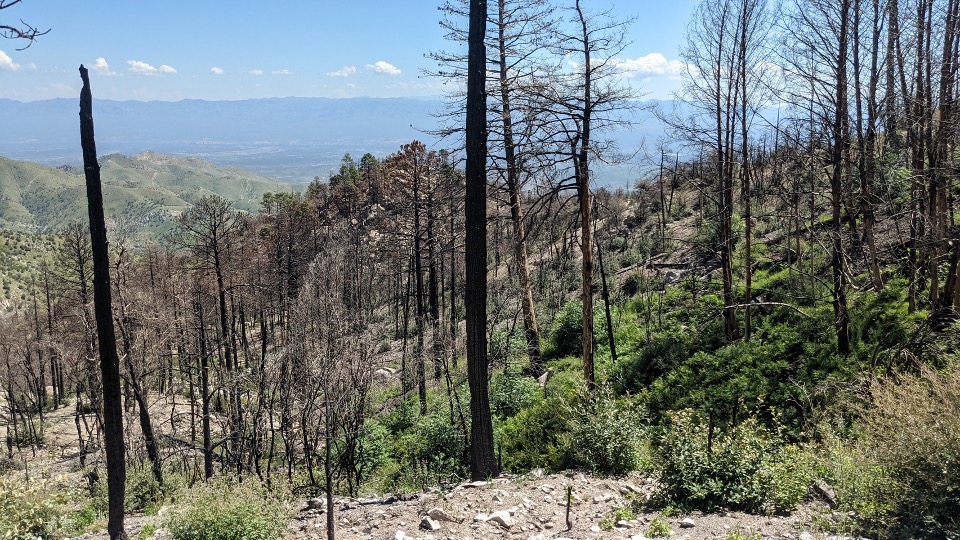Have you ever wondered why we spend so much time studying springs in the Sky Islands?
In the arid parts of North America, and especially in the west, springs are often the only water sources available for wildlife and people. Springs here in the southwest also harbor unique species, such as Bartram’s stonecrop, Chiricahua Leopard frogs, and tiny — almost invisible — snails (Pyrgulopsis spp.) found nowhere else in the world.
Springs are also important to migratory species: animals and birds will move hundreds of miles across the landscape in some cases and need stable water sources to rely on during their trips.
As climate changes and we see more heat waves, droughts, and fires occur, springs can act as refuges where plants and animals are protected. These bodies of water are also specific points (called “loci”) of regrowth. For example, this spring (pictured below) on the north side of the Santa Catalinas Mountains outside of Tucson, Arizona shows more plant regrowth right around the spring source than elsewhere on the hillside, even though the whole area was affected by a recent fire.

Photo caption: A spring in the Catalina Mountains showing regrowth after the Bighorn Fire.
What are some of the current threats that springs face in the region?
Springs are under great threat. Here are just a few of the things that strain water sources:
- Excessive pumping of groundwater for mining, agriculture, and border wall construction lowers the water table and can, in worst cases, cut off spring sources all together.
- Cattle grazing can lead to erosion around springs and stream banks, and trampling by livestock and people can damage or destroy fragile springs-dependent species.
- Pollution in runoffs caused by rain events can reduce water quality. (For example, runoff from mine tailings piles can introduce heavy metals into nearby streams or springs that wildlife rely on.)
And climate change threatens springs in numerous ways:
- Drought can increase evaporation and evapotranspiration, lowering the amount of water available at the surface and for plants and animals. Evaporation can also increase the concentration of minerals in the water, changing water chemistry and water quality.
- Flooding and excessive rainfall can lead to landslides or debris flows that bury springs permanently.
- Some environmental changes can favor the growth of invasive species, like bermuda grass, fountain grass, or even animals like bullfrogs.
With all of these threats and more front of mind, we want to figure out how to conserve springs that remain relatively natural, ensure that water sources with competing pressures (e.g., wildlife and cattle) remain available, and restore springs that have an overgrowth of invasive species or are at risk of being buried by erosion.
What’s being done for springs in the Sky Islands and how can I help?
1. Join Spring Seeker!
Sky Island Alliance is one of the few organizations dedicated to monitoring and locating springs for wildlife and people. Volunteer to become a Spring Seeker and help us locate and collect information about springs throughout the Sky Islands of the southwestern United States and northern Mexico.
You can also check out our events page to view current survey campaigns and water-related opportunities.
[Spring Seeker Stories: Bear and Grapevine Spring in the Southern Rincon Mountains]2. STEWARD A LOCAL SPRING
If you know of a spring on your property and you are interested in learning how to steward it, for nature or livestock or any other reason, please get in touch!
You can email our Habitat Conservation Manager Sarah Truebe at [email protected].
3. Learn about local springs
The Spring Stewardship Institute has many resources available to learn more about springs and get involved in taking care of these special places. Click the link above to visit their website.
If you are interested in water in rivers and washes, check out the Watershed Management Group’s Flow365 program or the Arizona Department of Environmental Quality’s Arizona Water Watch program. There are many ways to help resource managers understand where water is present on the landscape so we can make sustainable decisions into the future.
Finally, keep an eye on water-related legislation. Even small changes in spending at the state level could make a significant difference in groundwater protections. Recent legislative changes also now allow water to remain in the stream channel without landowners having to forfeit water rights — this is great news for nature!
